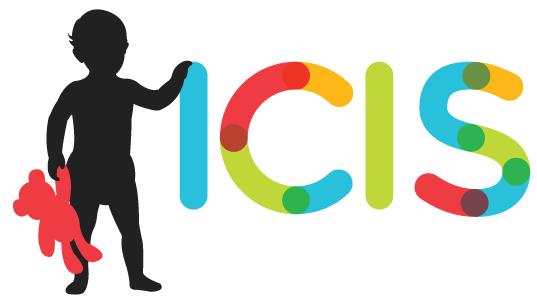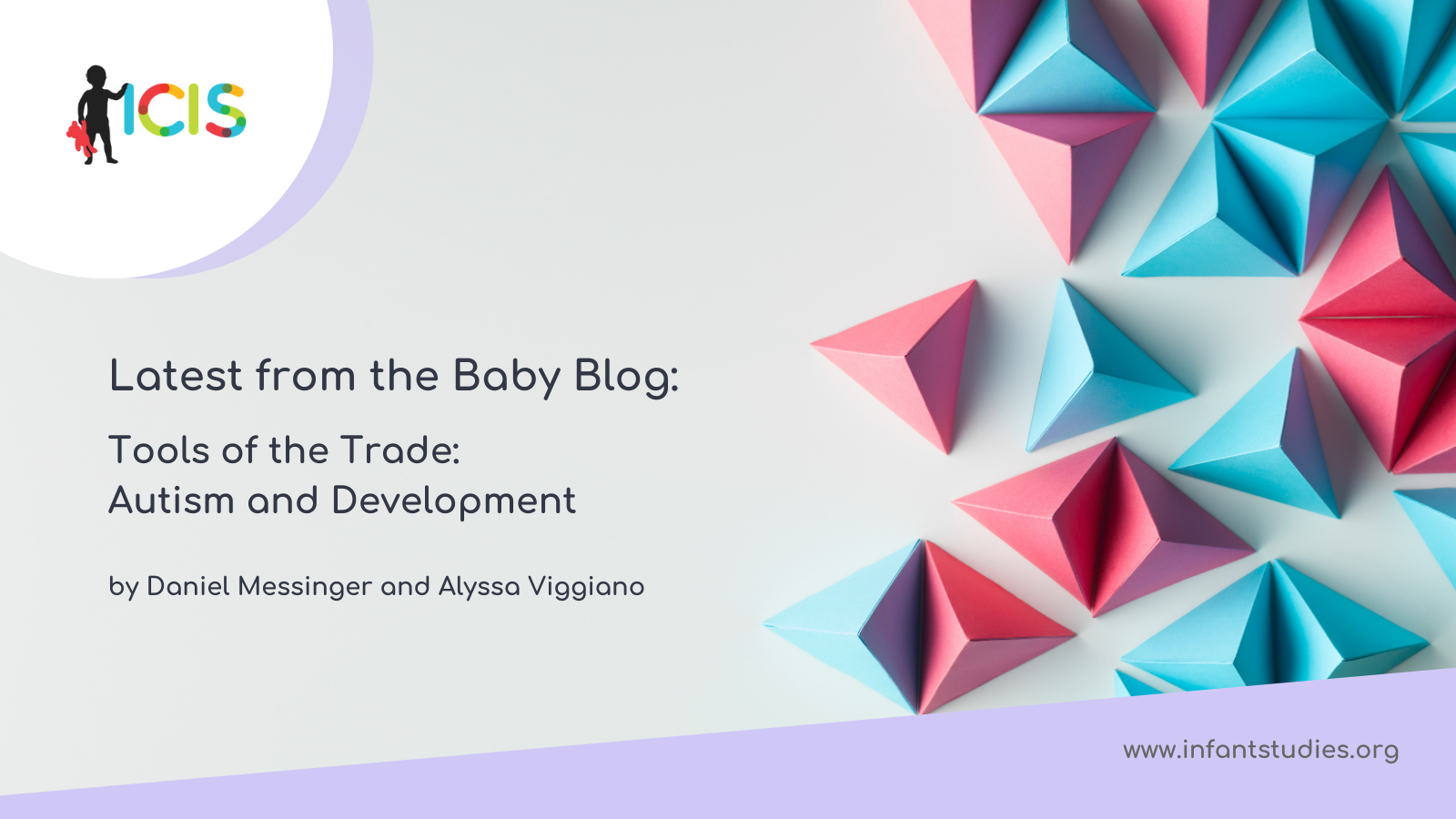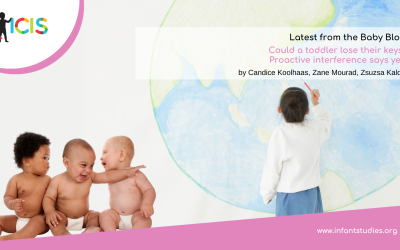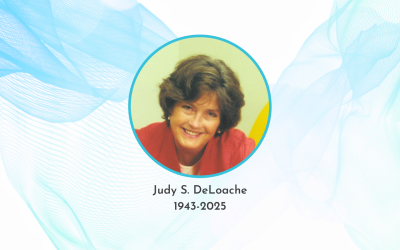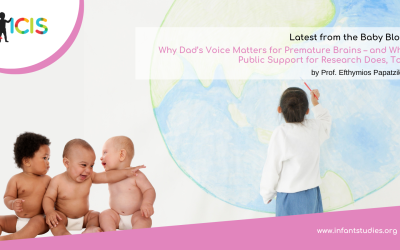by Daniel Messinger and Alyssa Viggiano
(Jointly authored; written from Daniel’s perspective)
Autism is a common and sometimes debilitating neurodevelopmental disorder whose symptoms typically emerge in the first three years of life. By focusing on three areas of autism research, I hope to illustrate autism’s attraction to the developmentalist. The three areas are (1) babysibs investigations, as well as research using objective measurements of autism relevant behavior (2) in the clinic as well as (3) in the classroom. First, though, a bit of personal history.
For the first 15 years of my career, my research focused on understanding the dynamics of development in what we frequently term “typically developing” infants. I was particularly interested in nonverbal communication—the interactive development of smiling, referential gaze, and gesture. Clinical syndromes—especially those like autism spectrum disorder (ASD) that involved exacting and occasionally confusing nomenclatures and technical diagnostic procedures—did not interest me. But Peter Mundy, a mentor and colleague, fatefully suggested to me that my expertise in nonverbal communication might be particularly suited to babysibs research. This was a crucial step in my own development.
Babysibs Research
Babysibs are the younger siblings of children with confirmed ASD. As detailed by Wilson (2023) in a recent BabyBlog, babysibs are at elevated likelihood for ASD simply because they have an older brother or sister with ASD. About one in five babysibs will themselves have an ASD outcome, and those without an ASD outcome can display subtle signs of the disorder (Charman et al., 2016; McDonald et al., 2019; Messinger et al., 2013; Messinger et al., 2015; Ozonoff et al., 2011). Fundamentally, babysibs research using its characteristic prospective design (following the infants at elevated likelihood over time) is tantalizing because it allows one to prospectively study the development of ASD. Salient examples involve sex differences, the concept of risk in the emergence of ASD, and ASD genetics.
A developmental perspective in babysibs research was helpful in understanding ASD sex differences (Messinger, et al., 2015). The clinical literature had not been clear whether girls with ASD had more or less severe symptoms than boys with ASD. The developmental design of babysibs research showed us that there were indeed sex differences in ASD symptoms between one and three years, but (arguably) they had nothing to do with ASD. As you might imagine, elevated likelihood infants with eventual ASD had the highest level of symptoms in our longitudinal design, followed by elevated likelihood infants without eventual ASD, followed by low likelihood infants. Strikingly, at least for me, boys had higher levels of restricted and repetitive behaviors—a key ASD symptom—than girls (Messinger, et al., 2015). And this sex difference held for all infants — whether or not they were at elevated risk for ASD, and whether or not they were eventually identified as having ASD. So, sex differences in ASD symptoms were simply a reflection of a larger normative difference between boys and girls (like girls’ higher levels of verbal abilities, which was also evident in this research). The clinical literature had suggested that sex differences in ASD reflected sex-specific manifestations of the disorder, which remains a distinct possibility and robust area of research (Burrows et al., 2022). Nevertheless, a parsimonious developmental perspective suggested that sex differences in ASD were simply a reflection of sex differences in infants more generally.
At a more personal level, the clinical import of ASD risk in babysibs research was an epistemological shocker that made me think about what is known, and not known, about development. Consider an infant at elevated likelihood for ASD, maybe a 6-month-old in the face-to-face/still face (FFSF) protocol. Let’s say this specific infant will be diagnosed with ASD two and half years in the future, at age 3. Did I believe an immutable causal mechanism was at play in the infant at 6 months? That is, did I believe ASD was latent in the infant, waiting to show itself? What about a more dynamic story? Would a series of developmental processes and cascades occur over the next two years of the infant’s life that would shape the emergence of their ASD? This latter approach was a more comfortable perspective for me. But did that perspective imply that the infant’s ASD could be avoided simply by altering their environment? Or if ASD could not be avoided, could the infant nevertheless develop functional skills that would improve their outcomes? Babysibs research made me confront the concrete implications of my theoretical commitments.
Empirical research certainly shed light on these developmental puzzles, but it did not make them less puzzling. ASD has recognizable behavioral characteristics in the third year of life but predicting those behaviors has proved challenging. Here’s an example. At six months, infants with eventual ASD show a less pronounced reduction in smiling from the play to the reunion episodes of the FFSF (Lambert-Brown et al., 2015). They show a lower ratio of gazing to the eyes (relative to the mouth) in eye-tracking tasks (Constantino et al., 2017; Jones et al., 2013). By 12 months, infants with later ASD show lower levels of initiating joint attention including joint attention that integrates smiling, referential looking, and coordination of multiple motor modalities (Adamson et al., 2019; Gangi et al., 2014; Iverson, 2021). Deficits in these triadic or referential communication abilities are characteristics of ASD itself. These are tantalizing results and reflect decades of productive research. But what predicts the deficits themselves?
One clue might be inheritance and genetic mutations. ASD research is interdisciplinary science and provided me an education—for example, in genetics–I would otherwise lack. ASD is highly heritable, yet genetic variants that confer high risk for ASD (highly penetrant variants) account for only a small percentage of ASD cases. Likewise, the combination of behavioral and genetic findings in babysibs research suggests that transmission of common negative variants also confers risk for ASD, but we do not know what common genetic variants are involved (D’Abate et al., 2019). It is understandable that an older child and their younger sibling, both with ASD, would have genetic variants linked to ASD. Paradoxically, however, the older and younger sibling may carry different genetic variants linked to ASD, suggesting that ASD risk may be associated with a susceptibility to such mutations rather than the presence of any specific one. Ultimately, ASD genetics can inform but not fully explain the emergence of ASD symptoms. However, some intellectual purchase on the emergence of ASD symptoms—such as a paucity of gazes to a partner’s face—can be gained by a foray into the world of ASD diagnosis and characterization.
Objectively measuring ASD-relevant behavior in the clinic
ASD is defined behaviorally, in that expert clinicians diagnose the disorder based on children’s behavior. We asked whether we could objectively quantify behaviors indexing autism symptoms during the gold standard clinical ASD assessment termed the ADOS (Autism Diagnostic Observation Schedule—remember my earlier trepidation about technical nomenclature and technical diagnostic procedures). Signal analysis of audio indicated that child vocalizations of higher frequency were associated with higher levels of ASD restricted and repetitive behavior symptoms (Moffitt et al., 2022). Furthermore, using computer vision tools, we found that lower levels of gazing at the parent’s face and lower levels of social smiling at the parent were associated with higher levels of ASD social-affective symptoms (Ahn et al., 2023). Well and good. Objective methods validated clinical characterizations of lower levels of social gaze at the parent in young children with ASD.
But wait. Adolph and West (2022) argue that gaze at the caregiver’s face is rare during naturalistic play with toys in both ASD and neurotypical kids (Yurkovic-Harding et al., 2022) and consequently that gazing at the caregiver’s face it is unlikely to be a mechanism for the emergence of the social deficits that characterize autism. However, our ADOS results suggest that gazing at the parent’s face—at least during playful but challenging interaction with a stranger—speaks to a different facet of everyday experience (Ahn, et al., 2023). In the ADOS, the child is confronted with challenges and surprises in which visually referencing the parent may be a key source of distraction from frustration and affective reassurance. Lower levels of gazing (and smiling) at the parent in this situation suggest that children with ASD are less likely to avail themselves of socioemotional information (and less likely to participate in socioemotional communication) crucial to confronting ambiguous situations. These results suggest (at least to me) a link between decreased social attention and ASD-linked social deficits. But we still lack a detailed understanding of how, for example, relative inattention to the eyes during social interaction contributes to ASD-linked deficits in referentiality and emotion expression.
ASD goes to preschool
Objective characterization of ASD cannot be limited to assessment settings like the ADOS. By definition, ASD involves persistent social communication deficits. But in practice we lack a quantitative sense of what those social communication deficits look like and the degree to which they are persistent or consistent across contexts. Given this, we tried to grab the bull by the horns by objectively measuring the physical movement and vocalizations of 3- to 5-year-old children with ASD and their neurotypical peers in inclusion preschools at weekly to monthly intervals over the course of the school year. On the technical side, we paired a real time location system with machine learning identification of children’s vocalization from lightweight audio recorders (Banarjee et al., 2023; Fasano et al., 2023; Fasano et al., 2021).
Patterns of homophily characterized the movement and social contact of children with ASD and their neurotypical (non-ASD) peers. That is, children tended to approach peers who were similar with respect to ASD status (ASD-ASD and neurotypical-neurotypical) more quickly than they approached less similar children (e.g., ASD-neurotypical). Likewise, although both children with ASD and neurotypical children spent more time in social contact with like children, ASD-ASD pairs spent less time in social contact than neurotypical-neurotypical pairs (Banarjee, et al., 2023).
Reminiscent of our investigation of babysib sex differences, what we learned about children’s vocalizations while in social contact reflected general communication patterns as well as ASD-specific deficits. First, the general pattern. For all kids in a preschool inclusion classroom, the number of vocalizations one child directed to another (e.g., José directed to David) on one observation (when we made objective measurements in the classroom) predicted the number of reciprocated vocalizations (e.g., David directed to José) on the next observation (typically 2 – 4 weeks away). This pattern of dyadic communication was true for children with ASD and for their neurotypical peers.
We think of the classroom as a network in which one child is connected to another (e.g., José and David) by the quantity of speech they direct to one another, which we call co-talk. Children with ASD tended to be isolated in the co-talk classroom network. Both their co-talk bonds with neurotypical children and their bonds with other children with ASD were weaker than the co-talk bonds between neurotypical children.
It turns out that co-talk is a strong predictor of children’s end-of-year assessed language abilities, a potent reminder of the importance of social communication in peer groups (Fasano, et al., 2021; 2023). Overall, children with ASD were both spoken to less than and spoke less to their peers than neurotypical children. Moreover, the assessed language abilities of children with ASD were depressed. But the link between co-talk and language abilities — between interaction and indices of development—did not vary by ASD status (Fasano, et al., 2021). The results suggest the potential of peer vocal interaction to support the language abilities of all children in a classroom.
Conclusion
In brief, ASD research affords infancy researchers the opportunity to engage with developmental processes of serious clinical import, and to consider the role of group dynamics in children’s lives. ASD research is fast-paced interdisciplinary science. In some of my non-ASD infancy research, a decade may pass before a finding is replicated, not replicated, or something in between. Not so in ASD research. In a year or so, the field often provides feedback on whether your latest result replicates. It is thus an important and exciting branch of infancy research.
References
Adamson LB, Bakeman R, Suma K, Robins DL (2019) An Expanded View of Joint Attention: Skill, Engagement, and Language in Typical Development and Autism. Child Development 90:e1-e18.https://doi.org/10.1111/cdev.12973.
Adolph KE, West KL (2022) Autism: The face value of eye contact. Curr Biol 32:R577-r580.10.1016/j.cub.2022.05.016. PMC9527854. NIHMS1838065.
Ahn YA, Moffitt JM, Tao Y, Custode S, Parlade M, Beaumont A, Cardona S, Hale M, Durocher J, Alessandri M, Shyu ML, Perry LK, Messinger DS (2023) Objective Measurement of Social Gaze and Smile Behaviors in Children with Suspected Autism Spectrum Disorder During Administration of the Autism Diagnostic Observation Schedule, 2nd Edition. J Autism Dev Disord.10.1007/s10803-023-05990-z.
Banarjee C, Tao Y, Fasano RM, Song C, Vitale L, Wang J, Shyu ML, Perry LK, Messinger DS (2023) Objective quantification of homophily in children with and without disabilities in naturalistic contexts. Sci Rep 13:903.10.1038/s41598-023-27819-6. PMC9845319.
Burrows CA et al. (2022) A Data-Driven Approach in an Unbiased Sample Reveals Equivalent Sex Ratio of Autism Spectrum Disorder-Associated Impairment in Early Childhood. Biol Psychiatry 92:654-662.10.1016/j.biopsych.2022.05.027. PMC10062179. NIHMS1877035.
Charman T et al. (2016) Non-ASD outcomes at 36 months in siblings at familial risk for autism spectrum disorder (ASD): A baby siblings research consortium (BSRC) study. Autism Res.10.1002/aur.1669.
Constantino JN, Kennon-McGill S, Weichselbaum C, Marrus N, Haider A, Glowinski AL, Gillespie S, Klaiman C, Klin A, Jones W (2017) Infant viewing of social scenes is under genetic control and is atypical in autism. Nature 547:340-344.10.1038/nature22999
http://www.nature.com/nature/journal/v547/n7663/abs/nature22999.html#supplementary-information.
Fasano RM, Perry LK, Zhang Y, Vitale L, Wang J, Song C, Messinger DS (2021) A granular perspective on inclusion: Objectively measured interactions of preschoolers with and without autism. Autism Research 14:1658-1669.10.1002/aur.2526.
Fasano RM, Mitsven SG, Custode SA, Sarker D, Bulotsky-Shearer RJ, Messinger DS, Perry LK (2023) Automated measures of vocal interactions and engagement in inclusive preschool classrooms. Autism Research n/a.https://doi.org/10.1002/aur.2980.
Gangi DN, Ibanez LV, Messinger DS (2014) Joint Attention Initiation With and Without Positive Affect: Risk Group Differences and Associations with ASD Symptoms. J Autism Dev Disord 44:1414-1424.10.1007/s10803-013-2002-9. Pmc4024338. Nihms544778.
Iverson JM (2021) Developmental Variability and Developmental Cascades: Lessons From Motor and Language Development in Infancy. Current Directions in Psychological Science:0963721421993822.10.1177/0963721421993822.
Jones W, Klin A (2013) Attention to eyes is present but in decline in 2-6-month-old infants later diagnosed with autism. Nature 504:427-431.10.1038/nature12715. Pmc4035120. Nihms527415.
Lambert-Brown BL, McDonald NM, Mattson WI, Martin KB, Ibañez LV, Stone WL, Messinger DS (2015) Positive emotional engagement and autism risk. Developmental Psychology 51:848-855.10.1037/a0039182.
McDonald NM, Senturk D, Scheffler A, Brian JA, Carver LJ, Charman T, Chawarska K, Curtin S, Hertz-Piccioto I, Jones EJH, Klin A, Landa R, Messinger DS, Ozonoff S, Stone WL, Tager-Flusberg H, Webb SJ, Young G, Zwaigenbaum L, Jeste SS (2019) Developmental Trajectories of Infants With Multiplex Family Risk for Autism: A Baby Siblings Research Consortium Study. JAMA Neurology.10.1001/jamaneurol.2019.3341.
Messinger D, Young GS, Ozonoff S, Dobkins K, Carter A, Zwaigenbaum L, Landa RJ, Charman T, Stone WL, Constantino JN, Hutman T, Carver LJ, Bryson S, Iverson JM, Strauss MS, Rogers SJ, Sigman M (2013) Beyond autism: A baby siblings research consortium study of high-risk children at three years of age. Journal of the American Academy of Child and Adolescent Psychiatry 52:300-308 e301.10.1016/j.jaac.2012.12.011. PMC3625370. Nihms431543.
Messinger DS, Young GS, Webb SJ, Ozonoff S, Bryson SE, Carter A, Carver L, Charman T, Chawarska K, Curtin S, Dobkins K, Hertz-Picciotto I, Hutman T, Iverson JM, Landa R, Nelson CA, Stone WL, Tager-Flusberg H, Zwaigenbaum L (2015) Early sex differences are not autism-specific: A Baby Siblings Research Consortium (BSRC) study. Mol Autism 6:32.10.1186/s13229-015-0027-y. Pmc4455973.
Moffitt JM, Ahn YA, Custode S, Tao Y, Mathew E, Parlade M, Hale M, Durocher J, Alessandri M, Perry LK, Messinger DS (2022) Objective measurement of vocalizations in the assessment of autism spectrum disorder symptoms in preschool age children. Autism Research, 15( 9), 1665– 1674 https://doiorg/101002/aur2731
Ozonoff S, Young GS, Carter A, Messinger D, Yirmiya N, Zwaigenbaum L, Bryson S, Carver LJ, Constantino JN, Dobkins K, Hutman T, Iverson JM, Landa R, Rogers SJ, Sigman M, Stone WL (2011) Recurrence risk for autism spectrum disorders: a Baby Siblings Research Consortium study. Pediatrics 128:15
Wilson R (2023) How quantitative evaluation of early infant movement may give us insight into autism. ICISS Babyblog. https://infantstudies.org/how-quantitative-evaluation-of-early-infant-movement-may-give-us-insight-into-autism/
Yurkovic-Harding J, Lisandrelli G, Shaffer RC, Dominick KC, Pedapati EV, Erickson CA, Yu C, Kennedy DP (2022) Children with ASD establish joint attention during free-flowing toy play without face looks. Current Biology.https://doi.org/10.1016/j.cub.2022.04.044.
About the Author

Daniel Messinger
University of Miami
Dr. Daniel Messinger is a professor in the Department of Psychology at the University of Miami where he has secondary appointments in Pediatrics, and Electrical and Computer Engineering. He is an interdisciplinary developmental psychologist who employs machine learning of audio, video, and ultrawideband sensors deployed in naturalistic contexts to understand the rules of early social interaction. Dr. Messinger employs computational approaches to big behavioral data to understand social, language and emotional development that have resulted in over 120 scientific publications appearing in high profile journals such as Infancy, Science Reports, Developmental Science, and Molecular Autism.

Alyssa Viggiano
University of Miami
Alyssa Viggiano is a first-year Ph.D. student in the joint Developmental and Child Clinical Psychology program at the University of Miami, co-mentored by Drs. Daniel Messinger and Michael Alessandri. She graduated with honors from Syracuse University, receiving her B.S. in Psychology and Neuroscience. Currently, she is working in the Early Play and Development Lab, leveraging objective measurements to study social and language development in typically developing children and children who are diagnosed or at-risk for autism spectrum disorder. Alyssa is interested in improving diagnostic accuracy of autism through utilizing automated, objective measurements to quantify behavior and examine gender differences in the development of autism.
